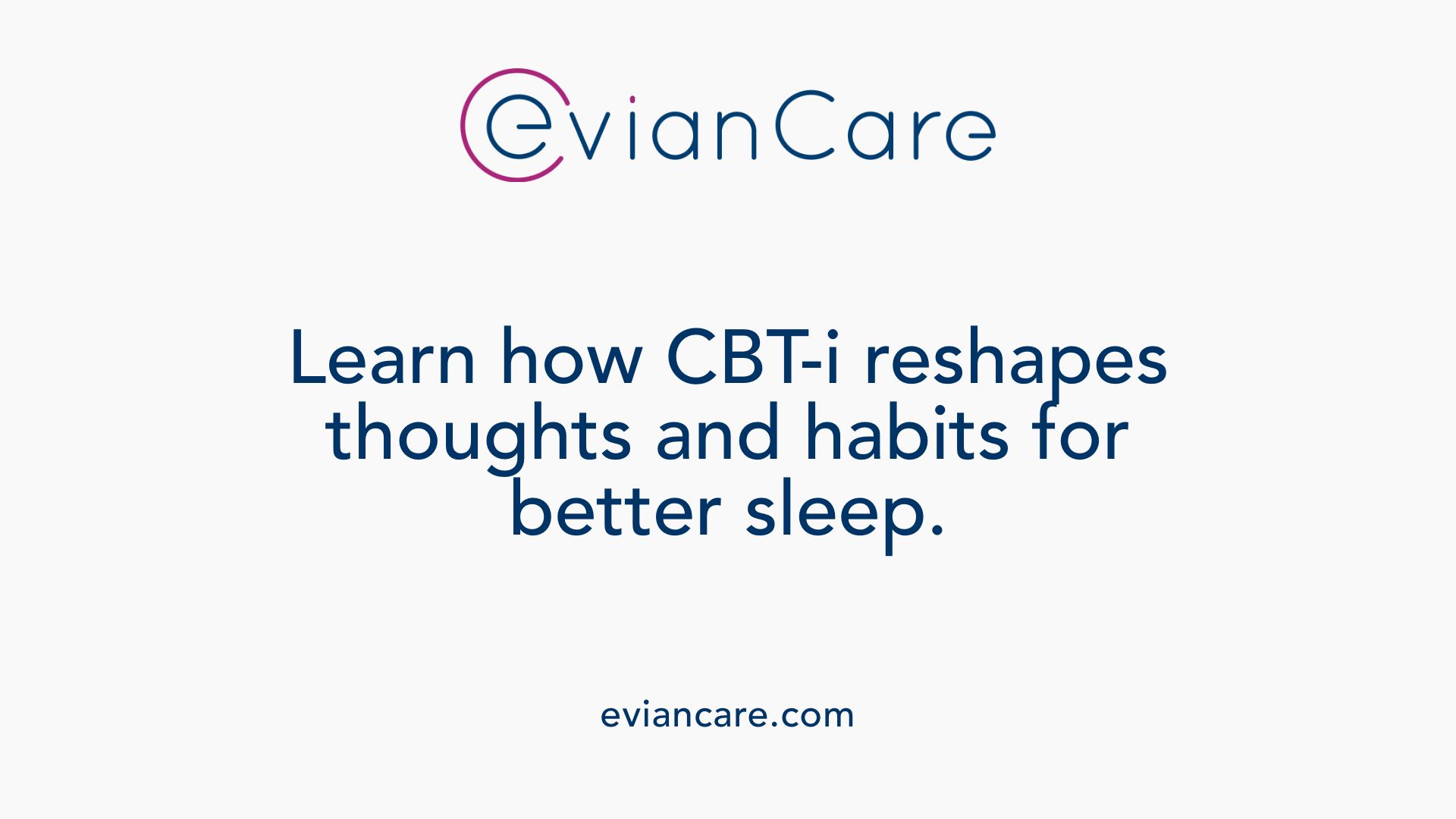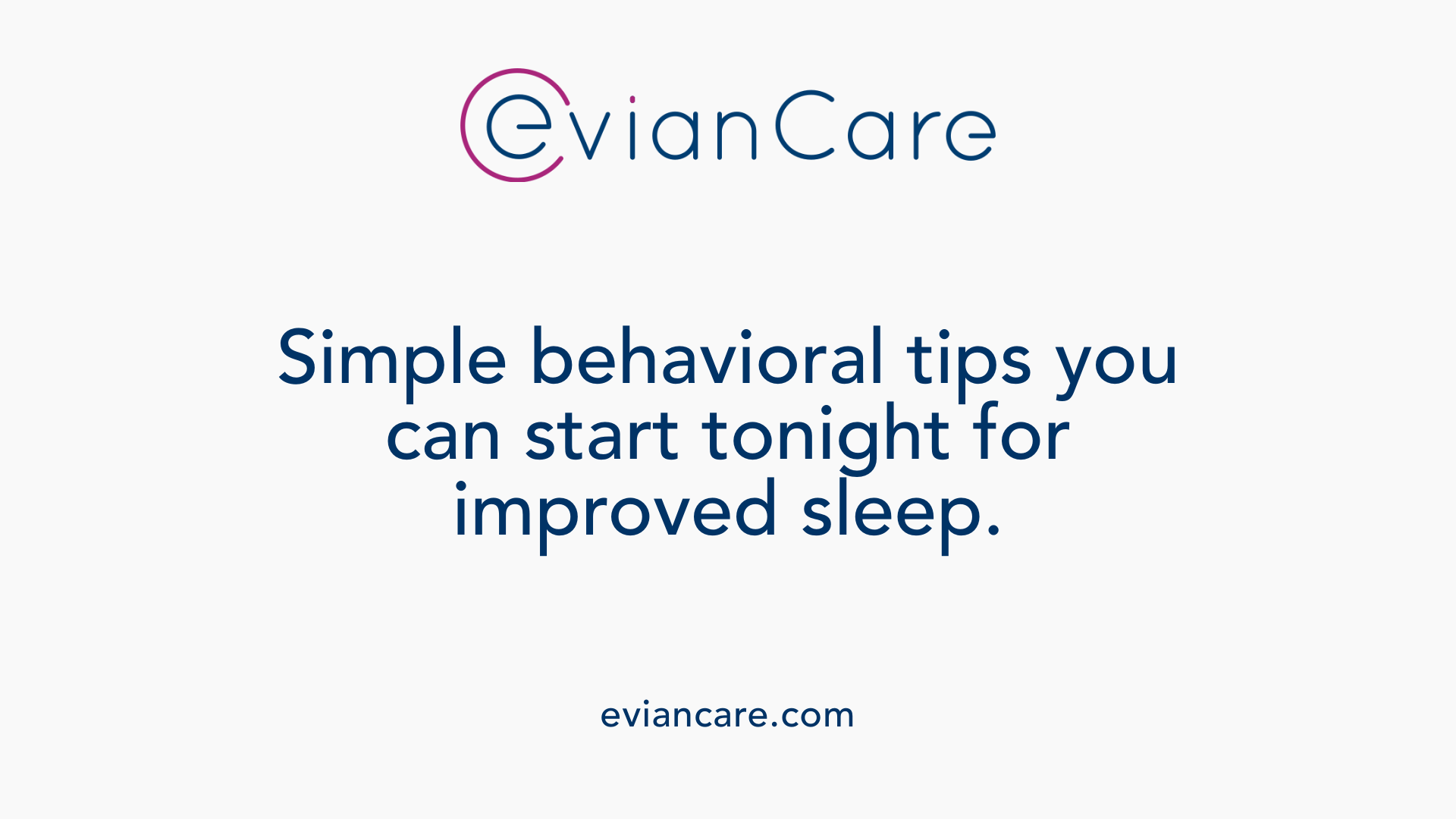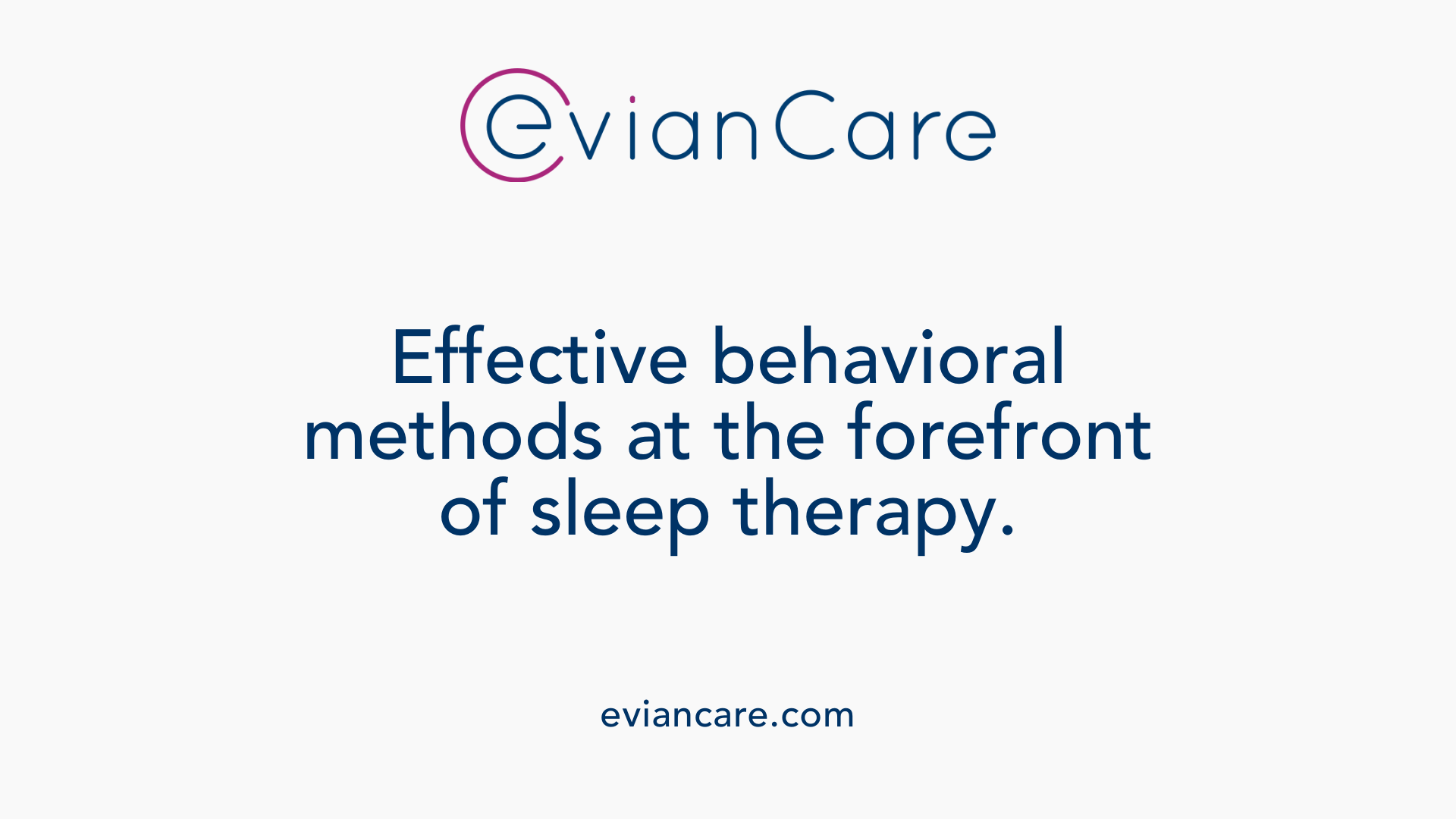
Understanding the Power of Behavioral Therapy for Sleep Improvement
Sleep disturbances are a common issue affecting millions worldwide, often rooted in habits, thoughts, and environmental factors. Behavioral therapy strategies, particularly cognitive-behavioral therapy for insomnia (CBT-i), have emerged as highly effective, evidence-based approaches to improving sleep patterns. This article explores various techniques, their mechanisms, and practical applications to help individuals achieve restful and restorative sleep.
What is Cognitive-Behavioral Therapy for Insomnia (CBT-i)?

What is cognitive-behavioral therapy for insomnia (CBT-i)?
Cognitive-behavioral therapy for insomnia (CBT-i) is a structured, evidence-based approach designed to improve sleep by addressing the thoughts, feelings, and behaviors that contribute to sleep problems. Unlike medication, which often masks symptoms, CBT-i targets the root causes of insomnia to produce lasting change.
Components of CBT-i
CBT-i includes several core techniques:
- Sleep education and hygiene: Learning about healthy sleep habits like maintaining a consistent sleep schedule, creating a comfortable sleep environment, and avoiding caffeine and screens before bedtime.
- Stimulus control: Training to associate the bed only with sleep and intimacy, and getting out of bed if unable to sleep after 20 minutes.
- Sleep restriction: Limiting time in bed to match actual sleep duration to boost sleep efficiency, then gradually increasing it.
- Relaxation techniques: Methods such as deep breathing, progressive muscle relaxation, mindfulness meditation, and guided imagery to calm the nervous system and prepare for sleep.
- Cognitive restructuring: Challenging and replacing negative thoughts about sleep with realistic, positive beliefs to reduce anxiety.
Delivery methods and duration
CBT-i can be offered through individual therapy, group sessions, or online programs. Typically, it lasts for 6 to 8 weekly sessions, each lasting about 45 to 60 minutes. Self-help books and digital platforms also provide accessible options for self-guided treatment.
Effectiveness and long-term benefits
Research shows that 70% to 80% of patients benefit from CBT-i, experiencing improved sleep quality and duration. The therapy’s effects are often durable, with many individuals maintaining improvements for years.
Comparison with medication
Unlike sleep medications, which may lead to dependency and have side effects, CBT-i offers a non-pharmacological solution that addresses the underlying causes of insomnia. It reduces or eliminates the need for medication and minimizes the risk of adverse effects, making it a preferred initial treatment for sleep difficulties.
| Aspect | Details | Additional Notes |
|---|---|---|
| Approach | Behavioral and cognitive techniques | Focuses on changing thoughts and habits |
| Sessions | 6-8 weekly sessions | Can be delivered online or in person |
| Duration of Benefits | Long-lasting | Often effective for years after treatment |
| Effectiveness | 70-80% success rate | Proven in numerous clinical trials |
| Compared to Medications | Fewer side effects | Addresses root causes of insomnia |
How Does CBT-i Address Sleep Problems?

Targeting negative thoughts and beliefs about sleep
Cognitive Behavioral Therapy for insomnia (CBT-I) focuses on identifying and challenging negative thoughts and misconceptions about sleep. Many individuals develop unhelpful beliefs such as 'I will never sleep well' or 'If I don't sleep soon, I will be exhausted all day.' CBT-I helps reframe these thoughts into more realistic and positive ones, reducing pre-sleep anxiety and worry. By altering these unhelpful beliefs, individuals can create a more relaxed mindset conducive to restful sleep.
Techniques such as stimulus control, sleep restriction, and relaxation training
CBT-I uses specific behavioral techniques to improve sleep quality. Stimulus control trains people to use their bed only for sleeping and intimacy, discouraging activities like watching TV or working in bed. Sleep restriction limits the time spent in bed to match actual sleep duration, strengthening the connection between bed and sleep. Relaxation training techniques—such as slow breathing, progressive muscle relaxation, and mindfulness—help calm the nervous system before bedtime, easing the transition to sleep.
Addressing behavioral and environmental factors
Behavioral and environmental adjustments form a core part of CBT-I. These include maintaining a consistent sleep schedule, creating a quiet, dark, and cool sleep environment, and avoiding stimulants like caffeine and nicotine close to bedtime. These modifications help reduce arousal and create conditions favorable for sleep. Psychoeducation about sleep hygiene reinforces these practices, empowering individuals to make sustainable changes.
Long-term habit formation and relapse prevention
A major goal of CBT-I is establishing durable sleep habits that prevent future problems. Patients learn strategies to maintain healthy routines, such as consistent waking times and minimizing screen exposure before sleep. The therapy also emphasizes identifying early signs of trouble and implementing preventative measures. This focus on lasting change makes CBT-I effective in providing sustained relief from chronic sleep difficulties, reducing reliance on sleep medications, and preventing relapse.
Behavioral Sleep Strategies You Can Implement Today

What are some behavioral sleep strategies?
Implementing good sleep habits can significantly improve sleep quality. These techniques focus on modifying behaviors and routines that influence sleep health.
One effective approach is establishing a consistent sleep schedule. Going to bed and waking up at the same times daily helps regulate your body's internal clock, making it easier to fall asleep and wake feeling rested.
Creating a relaxing bedtime routine is also crucial. This might include turning off bright lights, reading a book, listening to calming music, practicing meditation, or taking a warm bath. These activities signal to your body that it's time to wind down, promoting relaxation.
Optimizing your sleep environment plays a vital role. Keep your bedroom dark, quiet, and cool, ideally between 60-67°F. Using blackout curtains, earplugs, or white noise machines can help reduce disruptions.
Regular physical activity, especially aerobic exercises like walking, jogging, or resistance training, can improve sleep quality. For best results, exercise earlier in the day to prevent interference with your sleep.
Limiting screen time before bed is another effective strategy. The blue light emitted from phones, tablets, and computers can disrupt melatonin production, making it harder to fall asleep. Try to turn off electronic devices at least an hour before bedtime.
Additionally, avoiding caffeine, nicotine, and heavy meals close to bedtime supports better sleep. Practicing mindfulness techniques such as deep breathing or progressive muscle relaxation can reduce pre-sleep arousal, easing your transition into sleep.
These behavioral strategies are simple, yet powerful tools to help cultivate healthier sleep patterns. Consistency is key; over time, these habits can lead to improved sleep quality and overall well-being.
Behavioral Interventions in the Treatment of Sleep Disorders

What is a behavioral intervention to improve sleep?
A behavioral intervention to improve sleep is Cognitive Behavioral Therapy for Insomnia (CBT-I). This evidence-based approach includes several components designed to modify behaviors and thoughts that contribute to insomnia.
CBT-I helps establish healthy sleep habits by reducing sleep effort and correcting maladaptive beliefs about sleep. These components include stimulus control, sleep restriction, relaxation training, and cognitive restructuring.
Stimulus control involves training individuals to use their bed only for sleep and sex, helping to strengthen the bed-sleep association. Sleep restriction limits time in bed to match actual sleep duration, gradually increasing it as sleep quality improves.
Relaxation techniques such as deep breathing, progressive muscle relaxation, and mindfulness meditation help quiet the nervous system and prepare the body for sleep. Cognitive restructuring addresses negative thoughts and worries about sleep, promoting a more positive outlook.
Delivered typically in 6 to 8 sessions by trained professionals, or via digital and group formats, CBT-I is highly effective. It is recommended as the first-line treatment for chronic insomnia because of its proven efficacy, safety, and capacity for long-term benefits.
Overall, CBT-I targets the root causes of sleep issues, supporting sustainable sleep health and reducing reliance on medications.
Techniques Used in Sleep Therapy and Their Impact

What techniques are used in sleep therapy?
Sleep therapy uses a variety of approaches to help individuals overcome sleep problems, particularly insomnia. The foundation of many treatments is cognitive-behavioral therapy for insomnia (CBT-I), which focuses on changing negative thoughts, beliefs, and habits that disrupt sleep.
One of the main methods within CBT-I is thought challenging and cognitive restructuring. This involves identifying unhelpful or distorted thoughts about sleep, such as worries about not sleeping enough, and replacing them with more realistic and positive beliefs. This process reduces anxiety and conditioned arousal, making it easier to fall asleep.
Relaxation techniques are also central to sleep therapy. Techniques such as slow, deep breathing, progressive muscle relaxation, imagery training, and meditation help calm the nervous system. These methods reduce pre-sleep tension and racing thoughts, facilitating a smoother transition into sleep.
Beyond psychological techniques, physical methods like biofeedback and hypnosis serve to help individuals gain better control over physiological responses that can interfere with sleep. For example, biofeedback trains patients to regulate muscle tension and heart rate, while hypnosis can help reinforce positive sleep habits.
Light therapy is another tool used especially for circadian rhythm disorders. Exposure to bright light at strategic times helps reset internal biological clocks, improving synchronization of sleep-wake cycles.
Overall, these evidence-based techniques—ranging from cognitive restructuring and relaxation strategies to biofeedback, hypnosis, and light therapy—work together to modify sleep-related thoughts, behaviors, and physiological responses. They promote healthier sleep patterns, enhance sleep quality, and address the underlying causes of chronic sleep difficulties. In most cases, a personalized combination of these methods yields the best results for long-term sleep improvement.
Enhancing Sleep Quality through Behavioral and Cognitive Methods
How can behavioral and cognitive techniques improve sleep quality?
Behavioral and cognitive approaches are effective tools for improving sleep quality by targeting the habits, thoughts, and environmental factors that contribute to sleep problems like insomnia.
Techniques such as sleep restriction, stimulus control, cognitive restructuring, and relaxation training are central components of cognitive-behavioral therapy for insomnia (CBT-i). Sleep restriction involves limiting time in bed to match actual sleep time, which increases sleep drive and promotes more consolidated, restful sleep.
Stimulus control strategies help break the conditioned arousal associated with the bed, by only using the bed for sleep and intimacy. If a person can't fall asleep within 20 minutes, they are encouraged to leave the bedroom and engage in relaxing activities until sleepy again. This reinforces the association between bed and sleep.
Relaxation methods such as deep breathing, progressive muscle relaxation, and mindfulness meditation reduce physical tension and mental arousal that can delay sleep onset or cause wakefulness during the night.
Cognitive restructuring addresses underlying worries or negative beliefs about sleep, helping reduce anxiety related to sleep difficulties and fostering healthier sleep expectations.
Together, these techniques help reduce sleep latency, decrease wake times during the night, and increase total sleep duration.
Clinical studies demonstrate that these strategies can significantly improve sleep efficiency— the percentage of time spent in bed actually sleeping— and can do so without the side effects often linked to sleeping medications.
Maintaining these behavioral and cognitive habits results in sustainable improvements in sleep quality and tackles the root causes of many sleep disorders, offering a long-term solution rather than just symptom relief.
Summary and Final Recommendations
What are effective behavioral strategies for addressing sleep problems?
Addressing sleep issues effectively often involves a combination of behavioral techniques. Consistency is essential; maintaining a regular sleep schedule helps regulate the body's internal clock and promotes better sleep. Setting a fixed wake-up time and going to bed at the same hour each night reinforces healthy sleep patterns.
Creating an optimal sleep environment is also crucial. The bedroom should be cool, dark, quiet, and well-ventilated. Removing electronics and bright screens before bed reduces exposure to blue light, which can interfere with melatonin production.
Developing relaxing bedtime routines can ease the transition into sleep. Activities such as taking a warm bath, listening to calming music, or practicing gentle stretches can signal to your body that it's time to wind down.
Limiting daytime naps to 20-30 minutes, especially early in the afternoon, helps prevent sleep disruption at night. Also, avoiding naps late in the day maintains the buildup of sleep pressure needed to fall asleep.
Managing stress and worries is vital. Relaxation techniques like deep breathing exercises, journaling, mindfulness meditation, or progressive muscle relaxation can calm racing thoughts that often hinder falling asleep.
Why is consistency and environment important?
Consistency and a conducive sleep environment form the foundation of good sleep hygiene. Regular schedules help align your circadian rhythm, making it easier to fall asleep and wake up refreshed. A sleep-friendly environment minimizes disruptions, encourages sleep initiation, and enhances sleep quality.
What are the long-term benefits of CBT-i?
Cognitive Behavioral Therapy for Insomnia (CBT-i) offers lasting improvements in sleep by targeting the root causes of sleep disturbances. It helps establish healthier habits and thoughts about sleep, leading to sustained benefits even after therapy concludes.
Many individuals experience a reduction in sleep latency, fewer nighttime awakenings, and improved overall sleep efficiency. Importantly, CBT-i reduces reliance on sleep medications, lowering the risk of side effects.
Research shows that about 70% to 80% of patients notice significant and durable improvements, making it a preferred treatment option for chronic insomnia.
What are recommendations for integrating behavioral techniques?
Integrating behavioral strategies begins with education about sleep hygiene and establishing a routine that can be maintained long-term. Keeping a sleep diary helps identify patterns and obstacles. Gradually adjusting behaviors, like implementing stimulus control — using the bed only for sleep and intimacy — and sleep restriction therapy can be tailored to individual needs.
Combining these techniques with relaxation training, such as mindfulness or progressive muscle relaxation, enhances effectiveness. Staying committed to these changes and seeking support from sleep specialists or utilizing digital CBT-i programs can foster lasting improvements.
Overall, a holistic approach that combines consistent habits, environmental optimization, and psychological techniques provides the best prospects for overcoming sleep problems and promoting restorative sleep.
Empowering Better Sleep with Proven Behavioral Change
Adopting behavioral therapy strategies provides a sustainable and effective pathway to overcoming sleep difficulties. By understanding and implementing techniques such as stimulus control, sleep restriction, relaxation training, and maintaining good sleep hygiene, individuals can significantly improve their sleep quality, reduce dependence on medication, and enjoy better overall health. Consistency and creating an optimal sleep environment are vital for success, and seeking guidance from trained professionals can help tailor these strategies to personal needs. The evidence strongly supports behavioral approaches as the frontline method for managing insomnia and sleep-related problems, offering hope and practical solutions for achieving restorative sleep.
References
- Cognitive behavioral therapy instead of sleeping pills - Mayo Clinic
- Cognitive-Behavioral Therapy for Insomnia: An Effective and ...
- Cognitive Behavioral Therapy for Insomnia (CBT-I): An Overview
- Behavioral Strategies, Including Exercise, for Addressing Insomnia
- Sleep Therapy: Treating Sleep Problems with CBT - HelpGuide.org
- Care and Treatment Options for Sleep Problems - Health in Aging
- [PDF] Treating insomnia and other sleep problems with CBT
- Cognitive Behavioral Therapy for Insomnia | Stanford Health Care












